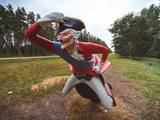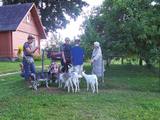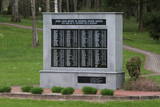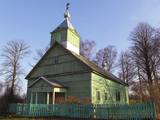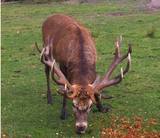| Nr | Name | Beschreibung |
|---|---|---|
|
Based on the tower of a former Soviet army radar installation, there is an 18-metre viewing tower at the Southern breakwater of Ventspils (Medņu Street) today. The tower offers a good view of the port territory, with the sea gate at the mouth of the Venta River and the city beach. Binoculars are available at the tower. It is worth walking down the Southern breakwater to get a better look at the sea.
|
||
|
Sēlijā, pie Slates sila, atrodas "Kalnaleiskini". Saimnieks Mārtiņš Uzkurs ir galdnieks, bet sieva Lelde - dizainere abu kopējā galdniecības uzņēmumā un Latvijas Ornitoloģijas biedrības biedre ar pieredzi ekskursiju vadīšanā. |
||
|
Ceļa malā, kas ved uz Kärdla pilsētu, ir zivju pārstrādes veikals, kur iespējams iegādāties Hījumā zvejnieku nozvejotas zivis gan svaigas, gan kūpinātas, kā arī tiek pārdoti Hījumā mazo ražotāju produkti. Zivis iespējams nobaudīt arī turpat uz vietas, veikalā ir kafejnīcas stūrītis, bet vasarā ārpusē ir terase.
|
||
|
Der zweitälteste Navigationsbau in Lettland, und der einzige, der sich 5 km vom Meeresufer entfernt an der obersten Seite des Baltischen Eissees befindet. Seit 2000 wird die Funktion des Leuchtturms hier nicht mehr erfüllt, stattdessen ist hier nun das Naturbildungszentrum „Slītere“ des Nationalparks Slītere untergebracht. Hier kann man Ausstellungen über lettische Leuchttürme und die Geschichte der Ostsee sehen. Aus dem obersten Geschoss (102 m über dem Meeresspiegel) kann man die Küste der Insel Saaremaa (ca. 33 km entfernt) sehen. Neben dem Leuchtturm verläuft der 1,2 km lange Slītere Naturpfad. |
||
|
Im erneuerten Herrenhaus des Gutshofes Dunte ist eine Exposition errichtet, die uns mit dem Leben und den Abenteuern des legendären Fantasten und Lügenbarons Münchhausen bekannt macht. Das Erdgeschoss des Museums ist dem Baron und seinenGeschichten gewidmet, im Obergeschoss kann man eine Wachsfigurenausstellung bedeutender Personen der lettischen Geschichte sehen, außerdem gibt es hier die größte Bierkrug-Sammlung Lettlands. Im Wald sind drei Wanderpfad-Runden mit Holzskulpturen errichtet, der längste davon führt bis zum Meeresstrand. Für Kinder gibt es ein Spielschiff aus Holz. |
||
|
The “Dabas zirgi” centre for horse and human welfare is in the historical Mežinieku neighbourhood in suburban Rīga, and it will be a revelation to those who wish to have a sense of belonging related to Latvia and its environment. Touch the forest, enjoy the cool water of the Misa River, encounter a swamp or see the breath of a horse on a foggy morning. You’re welcome to spend a longer amount of time at this venue with new glamping opportunities in a lovely forested area next to the steep shores of the Misa River. This offers complete silence with only the woods and the river nearby. Along with the horses, of course. “Dabas zirgi” offers strolls with a horse, tours involving feeding the animals, as well as horseback rides. Family celebrations are perfect here with a lean-to, a grill, and a pot on a campfire. Contact the venue in advance to arrange for prepared breakfast, lunch and dinner. There is also a sauna with a jacuzzi. |
||
|
The guest house is located in Odziena, Vietalva Parish, Plavinas Region. The house has 5 bedrooms, guests can enjoy a sauna, a pool and a swim in the pond, as well as fishing. There is a large surrounding area for organizing activities and other classes - the guest house is suitable for both relaxation and celebrations. |
||
|
Atrodas Rendā, pie tilta pār Abavu. Mazs, jauks krodziņš, kas atrodas vēsturiskā ēkā ar patīkamu interjeru. Piemērota maltītes ieturēšanas vieta ne tikai tiem, kas pārvietojas pa ceļu, bet arī Abavas laivotājiem. Strādā g.k. vasaras sezonā. |
||
|
Das Restaurant befindet sich im Zentrum von Rezekne (neben der Hochschule) und es ist in einem Gebäude mit gewölbtem Keller eingerichtet. Lettische Küche: Kalte Suppe, dünne Pfannkuchen, Kartoffelpfannkuchen, Schweinebraten, Schweinrippen, Frikadellen aus Kalbfleisch, geschmortes Lammfleisch, gebratener Kabeljau oder gebratene Forelle. Das besondere Gericht: Salat aus Ziegenkäse. |
||
|
Latgale Farmstead „Mežmalas”. The owners of the farmstead created an interesting collection of the old
household items, tools and equipment of the 19th and 20th century. The visitors are offered to try plainting of
the scale basket. Sale of baskets and herbal tea. Enjoy walking along the energetic path through the pine forest.
Working hours: on request |
||
|
In der Zeit des Zweiten Weltkrieges – Ende des Septembers im Jahr 1944 spielte sich in More eine von der blutigsten und grausamsten Kämpfe im Territorium Lettlands ab. Noch grausamer waren nur die Kämpfe im sogenannten „Kessel von Kurland” (Kurzemes katls). In der Kämpfen von More haben die auf der Seite Deutschlands kämpfenden lettischen Legionäre den Durchbruch der Roten Armee nach Riga verhindert, als auch die Einkreisung des deutschen Truppenteils 18 abgewehrt. Das Resultat der Kämpfe war wichtig für die örtliche Bevölkerung, (> 100 000), die Menschen könnten noch fliehen und solcherweise der späteren Repressionen entfliehen. Jedes Jahr wird hier im September Gedenkfeier gefeiert. Hier sammeln sich sowohl Augenzeuge dieser Vorgänge, als auch andere Interessenten. Hier wurde eine Memorialwand mit Namen der Legionäre, als auch einen in Stein gemeißelten Kreuz – das Gedenkzeichen für alle nicht identifizierten Gefallenen aufgestellt. 2 km östlich von dem Park ist ein Museum eingerichtet. Neben diesem Museum kann man einen sowjetischen Panzer besichtigen.
|
||
|
An afforested island in the Gulf of Finland, approximately 14 km to the North of Tallinn. There is a network of small roads and trails on the island. Forests: Mostly 1.1, 1.2 and 4.2. Information: www.aegna.ee. A ferry boat to the island departs from the port at Pirita. Hike around the shore of the island, where you will find all kinds of environments – dunes, sandy areas, rocky areas and places with lots of reeds (~9 km). |
||
|
Hier wird Viehzucht, Obstbau und Gemüsebau betrieben, sowie Milch und Fleisch erzeugt und verarbeitet. Die Wirte teilen ihr Wissen, wie man Käse (auf offenem Feuer) kocht und macht. Hier werden Brot nach Rezepten der Vorfahren gebacken und Hochzeitsfeiern nach den lettgallischen Traditionen angeboten. Lettische Küche: Roggenbrot, 14 verschiedene Käsesorten, Bauernsuppe, hausgemachtes Bier und eine Vorführung des Bierbrauens. Das besondere Gericht: Gefüllte Kartoffelpfannkuchen Gulbešnīki mit Pilzsoße. |
||
|
This park is in a region of hillocks in the Karula highlands, and Lake Ähijärve is at its centre. The park offers a cultural environment of small farms, and it was set up to protect the unique cupola-shaped hillocks of the area. Main attractions: Scenic Lake Ähijärv (176ha), Rebasemõisa Tornimägi hill (137.8 m above sea level), undulating landscapes. |
||
|
The Krimulda Castle was built in the latter half of the 13th century. It was located where the right bank of the ancient Gauja River valley is split by the deep Vikmeste ravine. The castle was owned by the council of archbishops from Rīga, and it was an impressive structure with a large interior courtyard and a defensive wall that was 1.5 m thick. The Swedish military blew up the castle when retreating in 1601. Today the castle hill is forested, and only a small fragment of the castle wall can still be seen. It is near the ruins that you will find the Sigulda aerial tram and the Krimulda serpentine road – the only object of its kind in the Baltic States. |
||
|
Aizputes pilsdrupas, akmens tilts pār Tebru, Jaunā pilsmuiža, ūdensdzirnavas un Sv. Jāņa luterāņu baznīca, kā arī 19. gs. beigās celtās koka ēkas starp Jāņa, Katoļu un Atmodas ielu veido neparastu pilsētbūvniecības kompleksu, kam piešķirts kultūras pieminekļa statuss. Staigājot pa vēsturisko centru, uzmanība jāpievērš ēku durvīm un to vērtnēm, logu ailēm, balkonu margām u.c. elementiem. |
||
|
Das größte Wasserkraftwerk Lettlands, der erste Bauabschnitt begann 1936 am rechten Daugavaufer (Architekt E. Laube). Das erste Maschinenhaus (mit einer Leistung von 17 MW das größte im gesamten Baltikum) wurde 1936 in Betrieb genommen. Von 1976 – 1979 fand der zweite Bauabschnitt des Kraftwerkes statt, dabei wurde ein neues Gebäude am linken Daugava-Ufer errichtet, drei neue Turbinen mit Generatoren aufgestellt und somit die Leistung des Kraftwerkes auf 260 MW gesteigert. Weitere Rekonstruktionen am Kraftwerk fanden von 1998 – 2001 am linken Daugava-Ufer statt, wo sich jetzt auch das Energetik- Museum befindet. |
||
|
Found at Rīgas Street 22A, this impressive building was suggested by Latvian President Kārlis Ulmanis and built in 1936 and 1937 after a design by the architect Verners Vitands. It is seen as one of the most outstanding architectural monuments from the first period of Latvian independence, and it is said that it was once the most modern multifunctional building in all of Europe. The building now houses the Daugavpils Theatre, the Latgale Central Library, the Latvian Cultural Centre, the Latvian House, the US Information Centre, the Daugavpils Tourism Information Centre and other institutions. Unity Square is alongside the building, and beautiful compositions of flowers are nearby during the growing season. |
||
|
Guriliški Old-Believers Prayer House was built in the beginning
of the 20th century. It has a very old bell that was made in 1939.
|
||
|
he wetland meadows that are around the Pededze River are the site of this 200 ha farm with some 350 red deer, other deer and wild boar. There are towers from which you can watch the graceful animals, and there are ponds for commercial fishing. Please contact the owner well in advance for a tour. |
||





